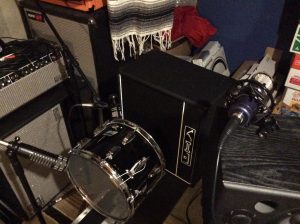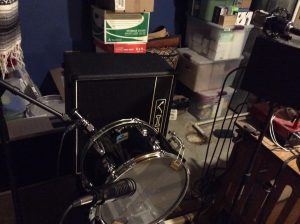I recorded h&s drums at the library’s studio across two sessions, and I didn’t love the snare sound from the first session. (Matt loaned me a few snares for the second session, which sounded fantastic.)
The plan had been to mix in a sample of a good snare hit along with the original track, but a couple weeks ago I realized I could try another technique; re-amping the snare. The advantage here is that a re-amped snare will have the same soft-to-loud dynamics and variations among individual hits as the original, where the sample is the same every time (and can therefore sound a bit artificial).
Here’s what it looks like:

The signal path:
- In the computer I’ve solo’d the snare track, and used a gate plugin set so only the snare hits come through (hi-hat and other bleed from the original drum performance is muted)
- That signal runs to the amp
- When the amp plays the snare hits, they excite the drum, almost like striking it with a stick
- The three mics are recorded as each song plays through, and I’ll mix them in with the original drum sounds
Short of going back in time and getting a better snare sound, this technique is working pretty well – the snare sounds from the first library drum session are drastically improved, and even the ones from the second session are benefitting a touch – and I’ve learned some things about it:
- (Obviously, in retrospect) the amplified version of the original snare sound bleeds into the mics along with the live drum resonance. Finding the right level of the amp to excite the drum but not dominate what the mics pick up takes some tweaking
- The drum is very responsive to EQ changes in the original snare track. Experimentation is encouraged
- (There was a third thing but I got sidetracked on Blue Dream‘s and Primal Rite‘s bandcamp pages…)
Long story short, if you find yourself in need of a different snare sound after a recording is done, try this one cool trick!

